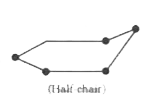The least stable form of hydrogen is
Molecular hydrogen
Nascent hydrogen
Atomic hydrogen
All are equally stable
To determine the least stable form of hydrogen, we need to analyze the different forms of hydrogen and their stability. Let's go through the solution step by step.
Step 1: Identify the forms of hydrogen
The three forms of hydrogen we need to consider are:
1. Molecular hydrogen (H₂)
2. Nascent hydrogen (H)
3. Atomic hydrogen (H)
Step 2: Define each form
- Molecular Hydrogen (H₂): This is the stable diatomic form of hydrogen, existing as a gas (H₂(g)).
- Nascent Hydrogen (H): This form of hydrogen is produced during chemical reactions, particularly in aqueous solutions. It is often referred to as "newly formed" hydrogen.
- Atomic Hydrogen (H): This is the form of hydrogen that exists as individual hydrogen atoms, typically produced when molecular hydrogen is dissociated.
Step 3: Analyze stability and reactivity
- Molecular Hydrogen (H₂) is the most stable form because it is in a stable diatomic state and has lower reactivity.
- Nascent Hydrogen (H) is less stable than molecular hydrogen because it is reactive and exists only briefly during chemical reactions.
- Atomic Hydrogen (H) is the least stable form as it is highly reactive due to the presence of individual hydrogen atoms. It tends to recombine quickly to form molecular hydrogen.
Step 4: Conclude the stability order
Based on the analysis:
- Stability Order: H₂ (most stable) > H (nascent hydrogen) > H (atomic hydrogen, least stable)
- Reactivity Order: H₂ (least reactive) < H (nascent hydrogen) < H (atomic hydrogen, most reactive)
Final Answer
The least stable form of hydrogen is atomic hydrogen (H).
---
The three forms of hydrogen we need to consider are:
1. Molecular hydrogen (H₂)
2. Nascent hydrogen (H)
3. Atomic hydrogen (H)
- Molecular Hydrogen (H₂): This is the stable diatomic form of hydrogen, existing as a gas (H₂(g)).
- Nascent Hydrogen (H): This form of hydrogen is produced during chemical reactions, particularly in aqueous solutions. It is often referred to as "newly formed" hydrogen.
- Atomic Hydrogen (H): This is the form of hydrogen that exists as individual hydrogen atoms, typically produced when molecular hydrogen is dissociated.
- Molecular Hydrogen (H₂) is the most stable form because it is in a stable diatomic state and has lower reactivity.
- Nascent Hydrogen (H) is less stable than molecular hydrogen because it is reactive and exists only briefly during chemical reactions.
- Atomic Hydrogen (H) is the least stable form as it is highly reactive due to the presence of individual hydrogen atoms. It tends to recombine quickly to form molecular hydrogen.
Based on the analysis:
- Stability Order: H₂ (most stable) > H (nascent hydrogen) > H (atomic hydrogen, least stable)
- Reactivity Order: H₂ (least reactive) < H (nascent hydrogen) < H (atomic hydrogen, most reactive)
The least stable form of hydrogen is atomic hydrogen (H).
Topper's Solved these Questions
Similar Questions
Knowledge Check
Whịch of the following is the least stable conformer of cyclohexane ?
A B
B C
C D
D
The least stable conformation of n-butane is
View SolutionThe least stable hydride is
View SolutionWhat is the enthalpy of formation of the most stable form of an element in its standard state ?
View SolutionThe most stable form of cis cyclohexane -1,3-diol is represented as :1
View SolutionFind the most stable form
View SolutionThe least stable ion among the following is
View SolutionThe most stable form of meso-tartaric acid is
View Solution
